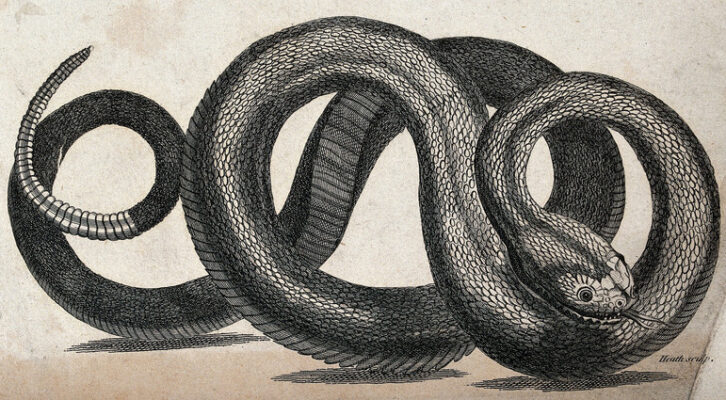
How the Rattlesnake Almost Became an Emblem of a Nascent America
Stephen S. Hall on the Centuries-Long Historical Evolution of a Serpentine Symbol
Benjamin Franklin was a snake guy. In fact, one could argue that he is the quintessential snake guy of the entire American Experiment, not because he was a herpetologist or popularizer (although he clearly had more than superficial familiarity with reptilian behavior), but because he recognized in the temperament of a fiercely independent and self-protective serpent the perfect symbol for the nascent American identity. His tour-de-force rattlesnake metaphor on the eve of the Revolutionary War is well known. It wasn’t, however, his first foray into literary allusions of a serpentine sort.
In the mid-18th century, England had the habit of exporting its criminal miscreants to North America, a policy the Crown cynically celebrated, as Walter Isaacson noted in A Benjamin Franklin Reader, “as a way to help the colonies grow.” The colonists did not appreciate the help. On May 9, 1751, writing to the Pennsylvania Gazette under the pen name Americanus, Franklin dipped his rhetorical pen in an ink pot of serpent venom for the first time in a brief and witty letter called “Rattlesnakes for Felons.” In a sly and indirect style of opinion writing that is as endangered these days as some rattlesnakes themselves, Franklin noted that venomous reptiles “we call rattle-snakes” populated the less inhabited precincts of the colonies; he likened the vipers to “felons-convict from the beginning of the world” and gently suggested that they shared a kindred outlaw spirit with the imported criminals.
He went on to heap faux praise on Mother England for its magnanimous policy, in which “all the Newgates and dungeons in Britain are emptied into the colonies.” Americans should be so grateful for British generosity, he continued, that he proposed a tongue-in-cheek exchange: sending North American rattlesnakes back to England as a token of appreciation. As Franklin noted (correctly), the snakes were “feeble, heavy, slow and easily taken” when they emerged from their dens in the spring. Thousands could be collected for a modest fee and sent as gifts to England.
He recognized in the temperament of a fiercely independent and self-protective serpent the perfect symbol for the nascent American identity.
“There I would propose to have them carefully distributed in St. James Park, in the spring-gardens and other places of pleasure about London; in the gardens of all the nobility and gentry throughout the nation; but particularly in the gardens of the Prime Ministers, the Lords of trade, and Members of Parliament; for to them we are most particularly obliged.” (In the perverse and improbable ways that satire begets latter-day tragedy, Franklin’s modest proposal was adapted for the purpose of real-life vengeance in 1978 when members of the California cult Synanon placed a large, de-rattled rattlesnake in the mailbox of a lawyer suing the group, resulting in a near-fatal envenomation and hospitalization; Synanon’s leader reportedly said, on audiotapes discovered during the ensuing police investigation, “Don’t mess with us”—a latter-day sentiment, too, that has echoes of Revolutionary-era defiance.)
Young Ben Franklin’s opinion of snakes in 1751 was not entirely positive, as is apparent in the concluding paragraph of the spicy dispatch from Americanus: “Rattle-snakes seem the most suitable returns for the human serpents sent us by our mother Country.” And “human serpents” persists as an all-purpose political insult; as recently as the 2024 election season, for example, former vice president Mike Pence was likened to a snake by a wary voter.
But in the two decades following the Americanus letter, images of a snake cropped up in many colonial publications, where it was understood to symbolize the need for unity. And Franklin’s view, equating human miscreants with squamates, apparently evolved over subsequent decades, because by the time of the American Revolution, he made an astonishingly good case that the rattlesnake would have been a more fitting symbol of strength and independence for the United States than the bald eagle.
This second invocation of the snake as metaphor took shape in Philadelphia late in 1775. The colonists wanted to intercept British naval shipments of arms to their troops, and young men were being recruited in the city to form naval units to accomplish this task. Franklin happened to notice that the image of a timber rattlesnake had been painted on the drum of one of the newly recruited marines marching through town, along with the legend “Don’t tread on me.” Soon thereafter, an anonymous contribution—signed “An American Guesser”—appeared in the pages of the Pennsylvania Gazette:
“The Rattlesnake as America’s Symbol.” Being the citizen-scientist he was, Franklin displayed a knowledge of reptile behavior in this much more famous essay, published on December 27, 1775. He understood that rattlesnakes (like all snakes) temperamentally prefer to avoid confrontation; their first line of defense is to slither off. But if perturbed or provoked, they will respond with a swift, painful, and potentially lethal response. Weaving that nugget of serpent behavior into political commentary, Franklin created one of the shrewdest metaphors in the history of American political rhetoric.
Weaving that nugget of serpent behavior into political commentary, Franklin created one of the shrewdest metaphors in the history of American political rhetoric.
After noting that “the ancients considered the serpent as an emblem of wisdom, and in a certain attitude of endless duration,” Franklin set out to enumerate all the distinguishing qualities of this particular animal. Familiar though the passage may be, it is worth pondering the political echo it still sends hurtling into recent times—something like the hum of the microwave background in our current political universe, echoing the Big Bang of America’s creation. Here is what Franklin had to say about the timber rattlesnake:
I recollected that her eye excelled in brightness, that of any other animal, and that she has no eye-lids. She may therefore be esteemed an emblem of vigilance. She never begins an attack, nor, when once engaged, ever surrenders: She is therefore an emblem of magnanimity and true courage. As if anxious to prevent all pretensions of quarrelling with her, the weapons with which nature has furnished her, she conceals in the roof of her mouth, so that, to those who are unacquainted with her, she appears to be a most defenseless animal; and even when those weapons are shown and extended for her defense, they appear weak and contemptible; but their wounds however small, are decisive and fatal. Conscious of this, she never wounds till she has generously given notice, even to her enemy, and cautioned him against the danger of treading on her.
Was I wrong, Sir, in thinking this is a strong picture of the temper and conduct of America? The poison of her teeth is the necessary means of digesting her food, and at the same time is certain destruction to her enemies. This may be understood to intimate that those things which are destructive to our enemies, may be to us not only harmless, but absolutely necessary to our existence…
’Tis curious and amazing to observe how distinct and independent of each other the rattles of this animal are, and yet how firmly they are united together, so as never to be separated but by breaking them to pieces. One of those rattles singly, is incapable of producing sound, but the rising of thirteen together, is sufficient to alarm the boldest man living.
Brilliant both as metaphor and prophecy, Franklin’s warning about “the danger of treading on her” echoed the by-then omnipresent image of the rattlesnake (including one engraved by Paul Revere) that for decades had appeared on numerous colonial broadsheets; specifying “thirteen” rattles, clearly referring to the 13 colonies, makes the political intent of the essay unmistakable. Almost simultaneous with the publication of Franklin’s rattlesnake essay, a delegate to the Continental Congress named Christopher Gadsden created a flag that visually recapitulated Franklin’s powerful text: It displayed the form of a coiled timber rattlesnake, fangs exposed and tongue aflicker, above the words DON’T TREAD ON ME, upon a bright-yellow background. A native of South Carolina and a colonel in the Continental army, Gadsden presented the banner that same month to Esek Hopkins, the first commander in chief of the Continental navy, and it was actually used to signal naval maneuvers during the war. It has ever after been known as the Gadsden flag.
Franklin’s rattlesnake metaphor—and Gadsden’s flag imagery— has slithered through American history ever since. Nearly a dozen states have offered vanity license plates featuring the rattlesnake and DON’T TREAD ON ME legend. The right-wing Tea Party adopted the Gadsden flag as its banner in 2010. And that same yellow flag was waved by some participants in the January 6, 2021, assault on the US Capitol—a reminder that symbols can be powerful, but also perverted. The essence of the metaphor is that the snake never seeks confrontation or attacks its enemy. On that infamous day, it was as if Ben Franklin’s rattlesnake had turned and bit the Republic itself in the ass. Meanwhile, in Gadsden’s native South Carolina, the state’s Department of Natural Resources now notes on its website that timber rattlesnakes “have been eliminated from much of the piedmont through the activities of people.”
__________________________________

Excerpted from Slither: How Nature’s Most Maligned Creatures Illuminate Our World by Stephen S. Hall. Copyright © 2025 by Stephen S. Hall. Published by Grand Central Publishing, a Hachette Book Group company. Reproduced by arrangement with the Publisher. All rights reserved.
Stephen S. Hall
Stephen S. Hall has been reporting and writing about the intersection of science and society for more than 40 years. In addition to numerous cover stories in the New York Times Magazine, where he also served as a Story Editor and Contributing Writer, his work has appeared in The New Yorker, The Atlantic Monthly, National Geographic, New York Magazine, Wired, Science, Nature, Scientific American, Discover, The Sciences, Hip-pocrates, Smithsonian, and more. He is also the author of six critically acclaimed non-fiction books about contemporary science. Among other honors, he has received the Walter Sullivan Award for Excellence in Science Journalism from the American Geophysical Union (2011); the Best Magazine Story of the Year from the American Association for the Advancement of Science-Kavli Foundation in 2017; and an honorary doctorate from Cold Spring Harbor Laboratory in 2023. He also received a Guggenheim Fellowship in 2012.
Since 2007 Hall has served as an adjunct professor of journalism at New York University, where he taught a core-curriculum graduate-school seminar in science writing at NYU’s Science, Health, and Environmental Reporting Program (SHERP) for ten years. He previously taught graduate seminars in science writing and explanatory journalism at Columbia University. Since 2009, he has also conducted hundreds of Science Communication Workshop sessions for scientists and doctors at NYU, Rockefeller University, Mt. Sinai School of Medicine, and Cold Spring Harbor Laboratory.



















